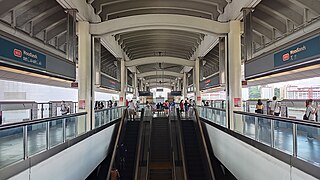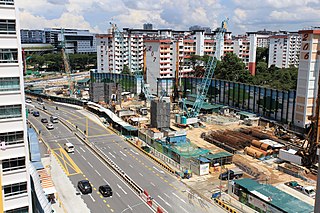
The Mass Rapid Transit system, locally known by the initialism MRT, is a rapid transit system in Singapore and the island country's principal mode of railway transportation. The system commenced operations in November 1987 after two decades of planning with an initial 6 km (3.7 mi) stretch consisting of five stations. The network has since grown to span the length and breadth of the country's main island – with the exception of the forested core and the rural northwestern region – in accordance with Singapore's aim of developing a comprehensive rail network as the backbone of the country's public transportation system, averaging a daily ridership of 3.4 million in 2019.

The North-South line (NSL) is a high-capacity Mass Rapid Transit (MRT) line in Singapore, operated by SMRT Corporation. Coloured red on the Singapore rail map, the line is 45 kilometres (28 mi) long and serves 27 stations, 11 of which, between the Bishan and Marina South Pier stations, are underground. It runs from Jurong East station, located in Western Singapore, to Marina South Pier station in the Central Area, via Woodlands station in northern Singapore. The line operates for 19 hours a day, with headways of up to 2 to 3 minutes during peak hours and 5 to 8 minutes during off-peak hours. All the trains on the North South Line run with a six-car formation.

Changi Airport MRT station is an underground Mass Rapid Transit (MRT) station serving Changi Airport and its supplementary structure Jewel in Changi, Singapore. It is the terminus of the Changi Airport branch of the East West line (EWL). The station is operated by SMRT Trains and is built in an east–west direction. The two ends of the station connects directly to Terminals 2 and 3 of Changi Airport.

Boon Lay MRT station is an above-ground Mass Rapid Transit (MRT) station on the East West line in Jurong West, Singapore. Located in Jurong West Central, Boon Lay station is one of the three stations that serve Jurong West New Town; the other two are Lakeside MRT station and Pioneer MRT station. Together with Boon Lay Bus Interchange and Jurong Point Shopping Mall, they form the Boon Lay Integrated Public Transport Hub.

Pasir Ris MRT station is an elevated Mass Rapid Transit (MRT) station on the East West line (EWL) in Pasir Ris, Singapore. Situated along Pasir Ris Central adjacent to Pasir Ris Bus Interchange and the White Sands Shopping Mall, it is the eastern terminus of the EWL and, as of June 2021, the only MRT station within Pasir Ris. The station exterior has the characteristic dome-shaped segmented roof also seen on other elevated EWL stations.

Tampines MRT station is a Mass Rapid Transit (MRT) interchange station on the East West (EWL) and Downtown (DTL) lines in Tampines, Singapore. Situated at the heart of the Tampines town centre next to Tampines Avenue 4, Tampines Central 4 and Tampines Central 5, it is in close proximity to the Tampines and Tampines Concourse bus interchanges. The station also serves the surrounding retail developments of Tampines Mall, Tampines One and Century Square.

Expo MRT station is a Mass Rapid Transit (MRT) interchange station on the East West line (EWL) and Downtown line (DTL) in the Tampines planning area, Singapore. The station lies between Changi City Point and the Singapore Expo, located along Changi South Avenue 1 at the junction of Expo Drive.

Tanah Merah MRT station is an elevated Mass Rapid Transit (MRT) interchange station on the East West line located in Bedok, Singapore. Other than the main service for the East West line, Tanah Merah station is also the terminus for the Changi Airport branch line, a spur of the East West line.

The history of the Mass Rapid Transit (MRT) system of Singapore commenced with its planning in the 1960s, which finally led to its opening in 1987 with the launch of the 6 km section of the North South Line from Yio Chu Kang to Toa Payoh.

Aljunied MRT station is an above-ground Mass Rapid Transit (MRT) station on the East West line (EWL) in Geylang, Singapore. Named after Aljunied Road, this station primarily serves Aljunied, one of the subzones that make up Geylang planning area. On the EWL, it is between the Paya Lebar and Kallang stations.

Joo Koon MRT station is an above-ground Mass Rapid Transit (MRT) station along the East West Line in Pioneer planning area, Singapore.

The Kawasaki Heavy Industries C151 is the first generation electric multiple unit (EMU) rolling stock in operation on the North South and East West lines of Singapore's Mass Rapid Transit (MRT) system, manufactured by a consortium led by Kawasaki Heavy Industries (KHI) under Contract 151. They were first introduced in 1987 and are the oldest trains in operation on the network.

The safety of the Mass Rapid Transit (MRT) system in Singapore was questioned by the public after several accidents on the system during the 1980s and 1990s. Most problems have been addressed, and many safety measures are visible to users of the system.

The Thomson–East Coast Line (TEL) is a medium-capacity Mass Rapid Transit (MRT) line in Singapore. Coloured brown on the rail map, it is fully underground. When completed, the line will serve 32 stations over 43 kilometres (27 mi) in length, becoming one of the world's longest driverless rapid transit lines. It runs along a combined north–south and east–west corridor, starting in the north at Woodlands town, passing through Upper Thomson and the towns of Ang Mo Kio and Bishan, before heading south to Orchard Road and Marina Bay, then running eastwards along the east coast through Kallang, Marine Parade and Bedok South, before ending at Upper East Coast.

Gul Circle MRT station is an elevated Mass Rapid Transit (MRT) station on the East West line (EWL). Located in Tuas, western Singapore, the station serves the surrounding industries of JTC Space @ Tuas and Mapletree Pioneer Logistic Hub. The station is operated by SMRT Trains.

Tuas West Road MRT station is an above-ground Mass Rapid Transit (MRT) station along the East West line in Tuas, Singapore. This station took its name from a nearby road. It is located along Pioneer Road, near the junction with Tuas West Road, and sits along the boundaries of the Tuas North, Tuas Bay and Tuas Promenade planning subzones.

Tuas Link MRT station is an elevated Mass Rapid Transit (MRT) station in western Singapore. Located in Tuas along Tuas West Drive, it is located close to Tuas Depot and Tuas Checkpoint. The station is the terminus of the East West line (EWL) and the westernmost station in Singapore.

The Cross Island Line (CRL) is a high capacity Mass Rapid Transit (MRT) line under development in Singapore. The eighth MRT line, the CRL will run in the general east–west direction from Changi to Jurong Industrial Estate via Loyang, Pasir Ris, Hougang, Ang Mo Kio, Sin Ming, Bukit Timah, Clementi and the West Coast. From Pasir Ris, the line will branch off to Punggol. Coloured lime on official maps, the 58-kilometre (36 mi) line will replace the East West Line as the longest line on the MRT network upon its complete opening by the 2040s, serving roughly about 27 stations. It will be the sixth MRT line to be completely automated and driverless, as well as the fourth high capacity MRT line.

The Pasir Ris rail accident was a train accident that occurred on 22 March 2016, at the track switch near Pasir Ris MRT station in Pasir Ris, Singapore, on the East-West MRT Line. A C151 train struck two SMRT Trains trainee track workers at around 60 km/h, resulting in their deaths. The two deceased workers were working on a track point machine at that time as part of a team of 15 track personnel. This incident was "the worst train accident" in Singapore MRT's history.

The Joo Koon rail accident, or sometimes referred to as the Joo Koon train collision, was an accident which happened on 15 November 2017, when a C151A train travelling at 16 kilometres per hour (9.9 mph) rear-ended a stationary C151A train at Joo Koon station on the East West MRT line, resulting in 38 injuries. The stationary train was in the process of being detrained due to a train fault. Both trains were operating under the recently installed Thales SelTrac CBTC signalling system at time of incident, and the Minister of Transport Khaw Boon Wan expressed that he was "disturbed" by an initial finding that "critical safety software" was inadvertently removed from the stationary train, possibly due to a malfunctioning signalling circuit, which led to the accident. This incident is the second train collision in Singapore MRT's history, after the Clementi rail accident.



































































